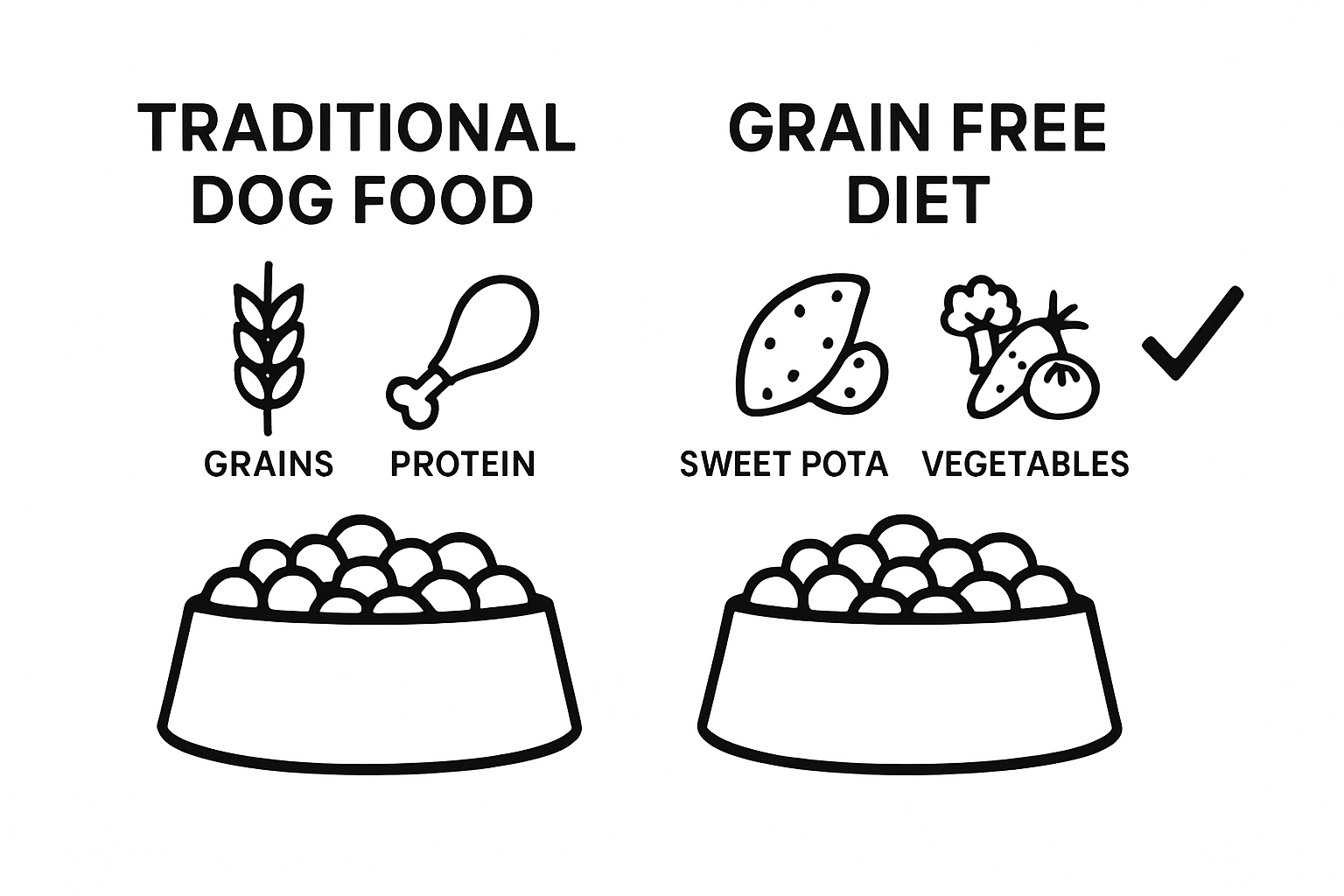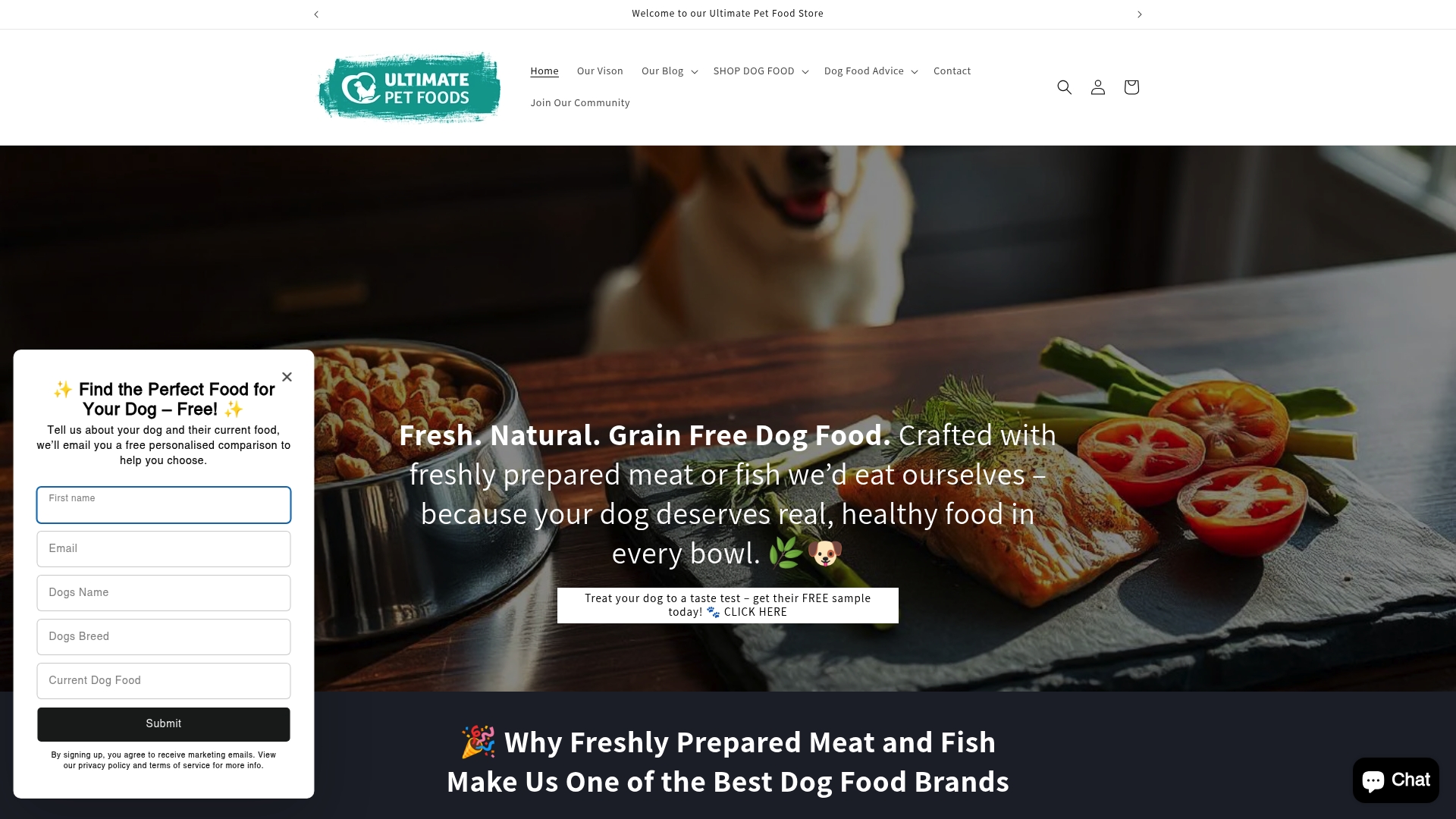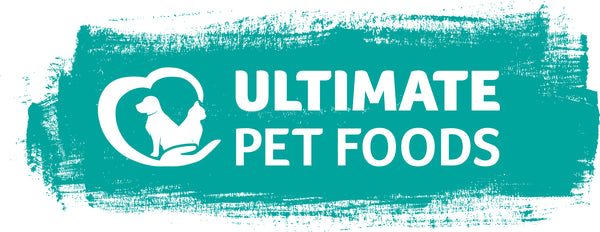
Understanding the Benefits of Grain Free Diet for Dogs
Share
Grain free diets for dogs have captured attention among pet owners searching for better nutrition. These diets often deliver higher protein content and swap out grains for alternatives like sweet potatoes and legumes. Most expect it is just about avoiding common allergens and digestive problems. Actually, there is much more to consider since not every dog truly benefits from going grain free.
Table of Contents
- What Is A Grain Free Diet And Why Choose It?
- Understanding The Nutritional Needs Of Dogs
- Health Benefits Associated With Grain Free Diets
- Common Myths And Misunderstandings About Grain Free Diets
- Guidelines For Transitioning To A Grain Free Diet
Quick Summary
| Takeaway | Explanation |
|---|---|
| Grain free diets exclude traditional grains | A grain free diet eliminates wheat, corn, rice, and barley, replacing them with alternative sources like sweet potatoes and legumes. |
| Higher protein content is beneficial | Grain free diets often have elevated protein levels, promoting better muscle development and overall health in dogs. |
| Individual needs dictate dietary choices | Each dog’s nutritional requirements vary based on breed, age, and health, so consult a vet for tailored advice. |
| Monitor for digestive changes during transition | Gradually introducing a new diet helps dogs adjust and minimizes gastrointestinal upset, ensuring smoother transitions. |
| Understand myths around grain free diets | Not all dogs need grain free nutrition; misconceptions exist about its benefits, highlighting the importance of individual assessment. |
What is a Grain Free Diet and Why Choose It?
A grain free diet for dogs represents a specific nutritional approach that eliminates traditional grains like wheat, corn, rice, and barley from their meals. Instead, these diets replace grains with alternative carbohydrate sources such as sweet potatoes, legumes, and vegetables.

Understanding Grain Free Nutrition
Traditional dog foods often contain grains as primary fillers and energy sources. However, grain free diets challenge this conventional approach by focusing on protein-rich ingredients and alternative carbohydrate sources. Learn more about nutrition alternatives in our guide on dog food ingredients.
According to research published in the journal Animals, grain free diets emerged from several key motivations:
- Addressing potential food sensitivities
- Mimicking more ancestral canine dietary patterns
- Supporting dogs with specific health conditions
Why Pet Owners Select Grain Free Options
Pet owners choose grain free diets for multiple reasons. Some dogs experience digestive challenges or allergic reactions to grains, making alternative nutrition crucial. These diets typically offer higher protein concentrations and more easily digestible ingredients, which can support overall canine health.
While grain allergies are relatively uncommon in dogs, some breeds and individual animals demonstrate improved wellness with grain free nutrition. The key is understanding your specific dog’s unique dietary requirements and consulting with veterinary professionals to determine the most appropriate nutritional strategy.
Ultimately, a grain free diet represents a thoughtful approach to canine nutrition that prioritizes wholesome, minimally processed ingredients tailored to support optimal dog health and vitality.
Below is a comparative table highlighting key differences between traditional grain-inclusive dog diets and grain free diets, as discussed in the article.
| Aspect | Traditional Grain-Inclusive Diet | Grain Free Diet |
|---|---|---|
| Main Carbohydrate Source | Wheat, corn, rice, barley | Sweet potatoes, legumes, vegetables |
| Protein Content | Typically moderate | Generally higher |
| Allergen Risk | Potential for grain allergies | Reduces risk of grain-related allergies |
| Digestibility | May cause issues in sensitive dogs | Often easier for sensitive dogs to digest |
| Common Usage | Standard, commercial dog foods | Targeted for specific health requirements |
| Ingredient Processing | Can be more processed | Emphasis on minimally processed foods |
Understanding the Nutritional Needs of Dogs
Canine nutrition represents a complex and nuanced field that requires understanding the specific dietary requirements that support optimal health and wellness in dogs. Different breeds, ages, and activity levels demand unique nutritional approaches to ensure comprehensive physiological support.
Core Nutritional Components
Dogs require a balanced diet that includes proteins, fats, carbohydrates, vitamins, and minerals. Proteins serve as the fundamental building blocks for muscle development, tissue repair, and immune function. Quality protein sources like freshly prepared meat or fish provide essential amino acids that cannot be synthesised by a dog’s body. Explore our comprehensive guide on holistic dog nutrition for deeper insights into balanced feeding strategies.
According to research from the University of Nottingham, proper nutritional formulation is crucial regardless of dietary approach. Key nutritional requirements include:
- High-quality protein sources
- Essential fatty acids
- Complex carbohydrates
- Micronutrients and trace minerals
Individual Nutritional Variations
Nutritional needs vary significantly across different life stages. Puppies require diets rich in calories and nutrients to support rapid growth, while senior dogs might need lower-calorie options with joint support supplements. Factors like breed size, genetic predispositions, and individual metabolism play critical roles in determining optimal nutrition.
Wholesome nutrition goes beyond mere calorie intake. It involves providing balanced, bioavailable nutrients that support metabolic functions, immune responses, and overall physiological wellness. Understanding your dog’s specific requirements through veterinary consultation and careful observation remains the most effective approach to tailoring their nutritional strategy.
Health Benefits Associated with Grain Free Diets
Grain free diets for dogs offer several potential health advantages that extend beyond traditional nutritional approaches. These diets focus on providing high-quality protein sources and alternative carbohydrates, which can support various aspects of canine wellness and metabolic function.
Digestive Health and Nutrient Absorption
Many dogs experience improved digestive performance with grain free nutrition. By eliminating common grain ingredients that can trigger sensitivities, these diets reduce potential inflammatory responses and support more efficient nutrient absorption. Learn more about managing dietary sensitivities in our guide on dog food for skin issues.
According to research from the University of Liverpool, dietary modifications can significantly impact canine health. Potential benefits of grain free diets include:
- Enhanced digestive efficiency
- Reduced inflammatory responses
- Improved nutrient utilisation
- Better management of food sensitivities
Comprehensive Wellness Support
Grain free diets typically incorporate protein-rich ingredients and complex carbohydrates from sources like sweet potatoes, legumes, and vegetables. These alternative ingredients provide essential nutrients while minimising potential allergenic compounds found in traditional grains. The approach supports overall metabolic function, potentially improving energy levels, coat quality, and immune system responses.
While individual responses vary, many dogs demonstrate improved vitality and wellness when transitioning to carefully formulated grain free nutrition. Pet owners should consult veterinary professionals to determine the most appropriate dietary strategy for their specific dog’s health requirements and nutritional needs.
Common Myths and Misunderstandings about Grain Free Diets
Grain free dog diets have become increasingly popular, yet numerous misconceptions surround their nutritional value and potential health impacts. Understanding the scientific evidence and veterinary perspectives is crucial for making informed dietary decisions for canine companions.
Debunking Nutritional Misconceptions
One prevalent myth suggests that grain free diets are inherently healthier for all dogs. In reality, nutritional requirements vary significantly between individual animals. Explore our comprehensive guide on understanding dog foods to avoid to gain deeper insights into balanced nutrition.
According to research from The Skeptic, several critical myths persist about grain free nutrition:
- Grain free automatically means healthier
- All dogs require identical nutritional approaches
- Grain elimination resolves all dietary sensitivities
- Commercial grain free diets are nutritionally complete
Scientific Perspectives on Grain Free Nutrition
Veterinary nutritionists emphasize that grain free does not necessarily equate to nutritionally superior. Many grain free diets replace traditional grains with alternative carbohydrate sources like legumes or potatoes, which may not always provide optimal nutritional profiles. Some dogs might actually require carefully balanced grain-inclusive diets to meet their specific metabolic needs.
Pet owners should approach grain free diets with a critical eye, consulting veterinary professionals and considering individual dog characteristics such as breed, age, activity level, and existing health conditions. Blanket nutritional recommendations rarely serve every dog’s unique physiological requirements.
Guidelines for Transitioning to a Grain Free Diet
Transitioning a dog to a grain free diet requires careful planning and systematic implementation to ensure optimal digestive adaptation and nutritional balance.
Abrupt dietary changes can lead to significant digestive disruptions, making a gradual, monitored approach essential for canine health and comfort.
Preparing for Dietary Transition
Successful dietary transitions demand thoughtful preparation and veterinary consultation. Discover expert strategies for smoothly changing your dog’s diet to minimise potential digestive complications. Introducing new foods incrementally allows your dog’s digestive system to adjust slowly and safely.
According to UK Pet Food guidelines, key considerations during dietary transitions include:
- Monitoring digestive responses
- Introducing new foods gradually
- Maintaining consistent portion sizes
- Watching for potential allergic reactions
- Tracking overall health and energy levels
Monitoring and Adaptation Process
The transition process typically spans 7-10 days, with gradual increases in the proportion of new grain free food. Begin by mixing approximately 25% new food with 75% existing diet, progressively adjusting ratios over subsequent days. Carefully observe your dog’s appetite, stool consistency, energy levels, and overall well-being throughout this period.
Pet owners should remain vigilant and communicate with veterinary professionals if significant digestive changes or adverse reactions occur.
Below, the table summarises the recommended process for safely transitioning a dog to a grain free diet, including key steps and considerations outlined in the article.
| Step | Description | Typical Duration | What to Monitor |
|---|---|---|---|
| Preparation | Consult a vet and plan gradual introduction | 1-2 days | Health status, previous diet |
| Initial Introduction | Mix 25% new food with 75% old food | Days 1-2 | Appetite, stool consistency |
| Gradual Increase | Increase new food to 50%, then 75%, then 100% | Days 3-7/10 | Digestive response, energy |
| Full Transition | Serve 100% grain free food | After day 7-10 | Overall well-being |
| Ongoing Monitoring | Regularly assess health and consult vet if needed | Continuous | Allergic reactions, vitality |
 Individual dogs respond differently to dietary modifications, emphasising the importance of personalised nutritional strategies and professional guidance.
Individual dogs respond differently to dietary modifications, emphasising the importance of personalised nutritional strategies and professional guidance.
Ready to See Real Benefits from Grain Free Nutrition?
If you are struggling with your dog’s digestive issues or persistent skin sensitivities, you are not alone. As discussed in the article, many owners are searching for natural, grain free solutions that can help their dogs thrive. Choosing the right grain free diet does not just avoid unnecessary fillers, it can help support better digestion, higher energy levels, and a shinier coat. Discover our expertly crafted complete grain-free dog food collections, each recipe designed to deliver hypoallergenic, protein-rich nutrition and support the health goals highlighted in your research.

Give your dog the gift of natural nourishment. Visit https://ultimatepetfoods.co.uk to browse our full grain-free range and see how switching to the best in British-made, fresh-ingredient foods can make a genuine difference. For tailored puppy nutrition, explore our grain-free dry puppy food range or support your senior dog’s wellbeing with our blends for senior dogs. Act now to help your dog enjoy a healthier, happier life today.
Frequently Asked Questions
What is a grain free diet for dogs?
A grain free diet for dogs eliminates traditional grains such as wheat, corn, rice, and barley, replacing them with alternative carbohydrate sources like sweet potatoes, legumes, and vegetables.
What are the potential benefits of a grain free diet for dogs?
Potential benefits include improved digestive health, better nutrient absorption, enhanced energy levels, and support for dogs with specific food sensitivities or health conditions, due to its focus on high-quality proteins and alternative carbohydrates.
How can I transition my dog to a grain free diet safely?
To safely transition your dog, gradually introduce the new grain free food over 7-10 days. Start by mixing approximately 25% new food with 75% existing food, and monitor your dog’s digestive response and overall well-being throughout the transition.
Are all dogs suited to a grain free diet?
Not all dogs require a grain free diet. Nutritional needs can vary significantly based on individual health, breed, age, and activity level. Consulting with your veterinarian is crucial to determine the best dietary approach for your dog.
Recommended
- What Ingredients to Avoid in Dog Food for Healthier Pups – Ultimate Pet Foods
- Understanding Dog Food for Skin Issues – Ultimate Pet Foods
- What is Kibble? Understanding Dog Food Choices – Ultimate Pet Foods
- Understanding Dog Foods to Avoid for Optimal Health – Ultimate Pet Foods
- Top Pet Health Tips Every Dog Owner Should Know – iPupPee
